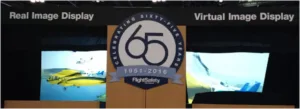Flight Safety showed perhaps the best demonstration of the benefits of a collimated display I have seen. It was a side-by-side demo that showed the same content.
On the left was a conventional front projection/screen combination. The screen was placed about 3-4 feet (1m-1.3m) from the viewing window (designated “real image” in the photo). On the right was a small collimated display that features their glass-based collimating reflection surface.
Looking at the image on the left was what one would expect to see. Objects look to be far away based on the scene, the object types, their scale and other visual cues. The image on the right was completely different. It provided much more of a scene of out the window view – even without it being stereoscopic.
The reason was explained as a human factors issue. In the real image display, the image is at focus on the screen at a few feet away from the viewer. Our eyes converge and focus on this point so our physiological cues suggest the image is only a few feet away. In the collimated display, our eyes are fooled to believe the image is focused at infinity. In this case there is no toe-in of the eyes – they are focused at infinity so our brain processes the images in a different way.
This change over happens at about 10 metres or 33 feet in the real world. In a collimated display and aircraft simulation application, most objects are more than 10 metres away so the overall image is incredible. But some applications require viewing objects closer than 10 meters such as aerial refueling and landing of rotary aircraft.
To solve this issue, one must now go to a true 3D display solution. Flight Safety now offers an aerial refueling trainer for the KC-46 aircraft that uses a stereoscopic 3D display to help the operator guide the refueling boom to the thirsty aircraft. Operators on the KC-10 and KC-35 don’t want to wear glasses to train, so Third Dimension Technologies’ multi-view light field display can address this need.
Flight safety also worked with Christie a few years ago to show a collimated display solution that integrated shutter glasses for close in work. – CC

